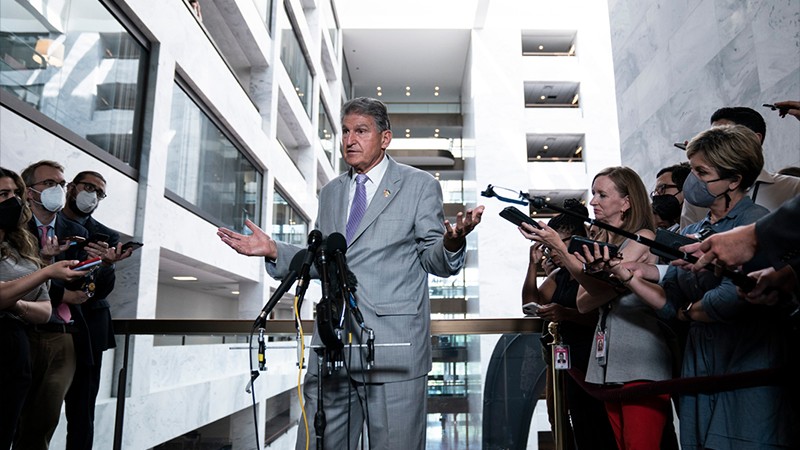As little as two weeks ago, a centrepiece of US President Joe Biden’s climate agenda seemed to be dead in the water, because of opposition from members of Congress. But after a surprise turn of events, the US Senate is poised to vote on the revived legislation — a massive spending bill that would make unprecedented investments in clean-energy innovation and deployment. Researchers say the legislation, if enacted, will reinvigorate efforts by the United States — and the world — to halt global warming.
The bill, revised by key Democrats in the evenly divided Senate, would invest around US$370 billion in a variety of low-carbon energy technologies over the coming decade. This includes tax credits for businesses to develop such technologies, which could reduce costs and attract more private-sector investment. The expenditure comes on top of more than $200 billion in clean-energy and climate investments that lawmakers approved in a major infrastructure bill last year.
“I think we will look back on this as a historic moment,” says Dan Lashof, who leads US operations for the World Resources Institute, an environmental think tank based in Washington DC. “This bill will have a tremendous impact on innovation and cost reductions for a whole set of clean-energy solutions that the world needs to reach its climate goals.”
The agreement to move the bill forwards comes just weeks after the US Supreme Court delivered a powerful blow to the Biden administration’s ability to meet its climate goals, by scaling back the Environmental Protection Agency’s authority to directly regulate greenhouse-gas emissions. However, the latest deal — which focuses on incentives and investments rather than rules and regulations — seeks to leverage the sheer size and power of the federal government to alter markets and drive down the price of clean-energy technologies.
Economic modelling by multiple energy-research groups indicates that the legislation could significantly reduce US emissions over the coming decade, bringing the country closer to delivering on its pledge to cut greenhouse-gas emissions to half of 2005 levels by 2030. The bill faces united opposition from Republicans, however, and Democrats will need the support of every one of their senators, plus a tie-breaking vote by vice-president Kamala Harris, to secure its passage.
A rebranded bill
Table of Contents
The legislation is a scaled-back version of the $2-trillion Build Back Better bill promoted by Biden last year, which included around $550 billion in energy and climate investments. That bill encountered opposition from conservative Democrats, including senator Joe Manchin from coal country in West Virginia, whose vote was crucial for it to succeed.
On 27 July, Manchin surprised some government watchers when he agreed to a new version that would dial down the bill’s overall price tag but maintain most of the original energy investments — including $160 billion in tax incentives for clean electricity and $35 billion for technologies intended to reduce vehicle emissions. Senate Democrats also rebranded the bill as the Inflation Reduction Act of 2022. The link to inflation rests in part on the argument that reducing costs for renewable power and electric vehicles will ultimately reduce consumers’ overall energy costs — a major contributor to rising inflation around the world.
Jesse Jenkins, an energy modeller at Princeton University in New Jersey, who heads a consortium that is analysing the legislation’s impacts, says the core energy and climate provisions have been preserved in the new agreement. Modelling by his group suggests that the legislation could reduce US emissions by the equivalent of nearly one billion tonnes of carbon dioxide per year by 2030, or two-thirds of the reduction needed to meet the US climate goal.
Other modelling efforts project similar trends if the legislation is enacted. Modelling by Energy Innovation, a consultancy based in San Francisco, California, suggests that annual US emissions could dip to 37–41% below 2005 levels by 2030. A third analysis by the Rhodium Group, a consultancy based in New York, projects they could drop to 31–44% below 2005 levels by 2030.
During the present decade, the models show, the bulk of the emissions reductions will probably be achieved in the electricity sector, thanks in large part to an expansion of wind and solar power, and in the transport sector, mostly owing to the shift towards electric vehicles. Innovations in clean-hydrogen and carbon-capture technologies could bring down emissions in the 2030s and beyond.
Consistency among the models lends confidence to the results, says John Bistline, an energy modeller at the Electric Power Research Institute, a non-profit organization in Palo Alto, California. Nonetheless, the models are not crystal balls, he says, and uncertainties around the pace of technological innovation, commercial deployment and consumer uptake could alter the trajectories.
Political compromise
For environmentalists, the revised spending bill contains some disappointments. To revive the bill, Democrats agreed to include requirements for the sale of new oil and gas leases, including in the Gulf of Mexico and on federal lands. They also agreed to work on separate legislation intended to speed up the approval process for energy projects, including fossil-fuel projects in Manchin’s home state of West Virginia.
Some environmentalists have blasted those provisions as counterproductive, but Jenkins says the move is perhaps understandable, given higher oil and gas prices in the wake of Russia’s war in Ukraine. His group’s modelling suggests that the fossil-fuel incentives have a fairly minor impact on the overall trajectory of energy and emissions trends.
“This is the price of political compromise,” he adds.
The US Senate could vote on the legislation as early as this week. Attention has now shifted to one last holdout among the Democrats, Kyrsten Sinema of Arizona, a senator who has gone against her party on the issue of tax increases in the past. If the bill clears the Senate, the House of Representatives — where the Democrats have a majority — is expected to follow suit and send the bill to Biden for signature.

